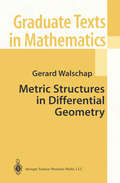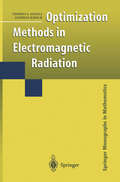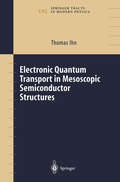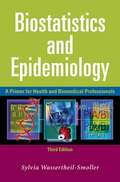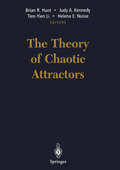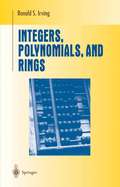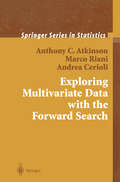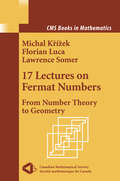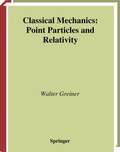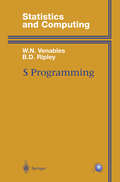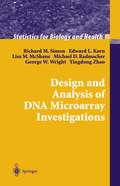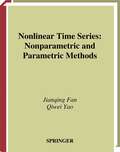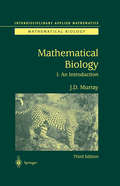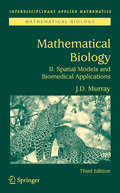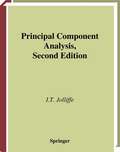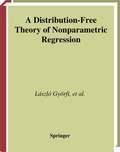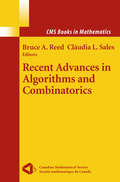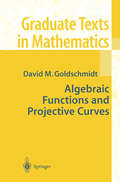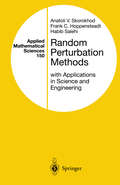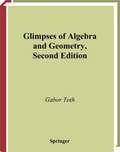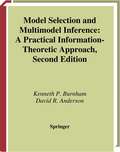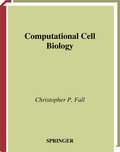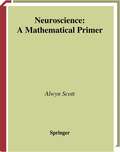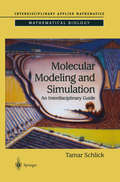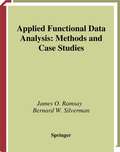- Table View
- List View
Metric Structures in Differential Geometry (Graduate Texts in Mathematics #224)
by Gerard WalschapThis book offers an introduction to the theory of differentiable manifolds and fiber bundles. It examines bundles from the point of view of metric differential geometry: Euclidean bundles, Riemannian connections, curvature, and Chern-Weil theory are discussed, including the Pontrjagin, Euler, and Chern characteristic classes of a vector bundle. These concepts are illustrated in detail for bundles over spheres.
Optimization Methods in Electromagnetic Radiation (Springer Monographs in Mathematics)
by Thomas S. Angell Andreas KirschThis book considers problems of optimization arising in the design of electromagnetic radiators and receivers, presenting a systematic general theory applicable to a wide class of structures. The theory is illustrated with examples, and indications of how the results can be applied to more complicated structures. The final chapter introduces techniques from multicriteria optimization in antenna design. References to mathematics and engineering literature guide readers through the necessary mathematical background.
Electronic Quantum Transport in Mesoscopic Semiconductor Structures (Springer Tracts in Modern Physics #192)
by Thomas IhnOpening with a brief historical account of electron transport from Ohm's law through transport in semiconductor nanostructures, this book discusses topics related to electronic quantum transport. The book is written for graduate students and researchers in the field of mesoscopic semiconductors or in semiconductor nanostructures. Highlights include review of the cryogenic scanning probe techniques applied to semiconductor nanostructures.
Biostatistics and Epidemiology: A Primer for Health and Biomedical Professionals
by Sylvia Wassertheil-SmollerFor the new edition of Biostatistics and Epidemiology, Dr. Wassertheil-Smoller has included several new chapters (genetic statistics, molecular epidemiology, scientific integrity and research ethics) and a new appendix on the basic concepts of genetics and a glossary of genetic terminology. She has also expanded the coverage of multi-center trials (an important aspect of implementation of the standards of evidence-based medicine), controversies in screening for prostate, colon, breast, and other cancers.
The Theory of Chaotic Attractors
by Brian R. Hunt Judy A. Kennedy Tien-Yien Li Helena E. NusseThe editors felt that the time was right for a book on an important topic, the history and development of the notions of chaotic attractors and their "natu ral" invariant measures. We wanted to bring together a coherent collection of readable, interesting, outstanding papers for detailed study and comparison. We hope that this book will allow serious graduate students to hold seminars to study how the research in this field developed. Limitation of space forced us painfully to exclude many excellent, relevant papers, and the resulting choice reflects the interests of the editors. Since James Alan Yorke was born August 3, 1941, we chose to have this book commemorate his sixtieth birthday, honoring his research in this field. The editors are four of his collaborators. We would particularly like to thank Achi Dosanjh (senior editor math ematics), Elizabeth Young (assistant editor mathematics), Joel Ariaratnam (mathematics editorial), and Yong-Soon Hwang (book production editor) from Springer Verlag in New York for their efforts in publishing this book.
Integers, Polynomials, and Rings: A Course in Algebra (Undergraduate Texts in Mathematics)
by Ronald S. IrvingThis book began life as a set of notes that I developed for a course at the University of Washington entitled Introduction to Modern Algebra for Tea- ers. Originally conceived as a text for future secondary-school mathematics teachers, it has developed into a book that could serve well as a text in an - dergraduatecourseinabstractalgebraoracoursedesignedasanintroduction to higher mathematics. This book di?ers from many undergraduate algebra texts in fundamental ways; the reasons lie in the book’s origin and the goals I set for the course. The course is a two-quarter sequence required of students intending to f- ?ll the requirements of the teacher preparation option for our B.A. degree in mathematics, or of the teacher preparation minor. It is required as well of those intending to matriculate in our university’s Master’s in Teaching p- gram for secondary mathematics teachers. This is the principal course they take involving abstraction and proof, and they come to it with perhaps as little background as a year of calculus and a quarter of linear algebra. The mathematical ability of the students varies widely, as does their level of ma- ematical interest.
Exploring Multivariate Data with the Forward Search (Springer Series in Statistics)
by Anthony C. Atkinson Marco Riani Andrea CerioliThis book is concerned with data in which the observations are independent and in which the response is multivariate. Companion book to Robust Diagnostic Regression Analysis (ISBN 0-387-95017) published by Springer in 2000.
17 Lectures on Fermat Numbers: From Number Theory to Geometry (CMS Books in Mathematics)
by Michal Krizek Florian Luca Lawrence SomerThe pioneering work of Pierre de Fermat has attracted the attention of mathematicians for over 350 years. This book provides an overview of the many properties of Fermat numbers and demonstrates their applications in areas such as number theory, probability theory, geometry, and signal processing. It is an ideal introduction to the basic mathematical ideas and algebraic methods connected with the Fermat numbers.
Classical Mechanics: Point Particles and Relativity (Classical Theoretical Physics)
by Walter GreinerIntended for advanced undergraduates and beginning graduate students, this text is based on the highly successful course given by Walter Greiner at the University of Frankfurt, Germany. The two volumes on classical mechanics provide not only a complete survey of the topic but also an enormous number of worked examples and problems to show students clearly how to apply the abstract principles to realistic problems.
S Programming (Statistics and Computing)
by William Venables B.D. RipleyS is a high-level language for manipulating, analysing and displaying data. It forms the basis of two highly acclaimed and widely used data analysis software systems, the commercial S-PLUS® and the Open Source R. This book provides an in-depth guide to writing software in the S language under either or both of those systems. It is intended for readers who have some acquaintance with the S language and want to know how to use it more effectively, for example to build re-usable tools for streamlining routine data analysis or to implement new statistical methods. One of the outstanding strengths of the S language is the ease with which it can be extended by users. S is a functional language, and functions written by users are first-class objects treated in the same way as functions provided by the system. S code is eminently readable and so a good way to document precisely what algorithms were used, and as much of the implementations are themselves written in S, they can be studied as models and to understand their subtleties. The current implementations also provide easy ways for S functions to call compiled code written in C, Fortran and similar languages; this is documented here in depth. Increasingly S is being used for statistical or graphical analysis within larger software systems or for whole vertical-market applications. The interface facilities are most developed on Windows® and these are covered with worked examples. The authors have written the widely used Modern Applied Statistics with S-PLUS, now in its third edition, and several software libraries that enhance S-PLUS and R; these and the examples used in both books are available on the Internet. Dr. W.N. Venables is a senior Statistician with the CSIRO/CMIS Environmetrics Project in Australia, having been at the Department of Statistics, University of Adelaide for many years previously. Professor B.D. Ripley holds the Chair of Applied Statistics at the University of Oxford, and is the author of four other books on spatial statistics, simulation, pattern recognition and neural networks. Both authors are known and respected throughout the international S and R communities, for their books, workshops, short courses, freely available software and through their extensive contributions to the S-news and R mailing lists.
Design and Analysis of DNA Microarray Investigations (Statistics for Biology and Health)
by Richard M. Simon Edward L. Korn Lisa M. McShane Michael D. Radmacher George W. Wright Yingdong ZhaoThe analysis of gene expression profile data from DNA micorarray studies are discussed in this book. It provides a review of available methods and presents it in a manner that is intelligible to biologists. It offers an understanding of the design and analysis of experiments utilizing microarrays to benefit scientists. It includes an Appendix tutorial on the use of BRB-ArrayTools and step by step analyses of several major datasets using this software which is available from the National Cancer Institute.
Nonlinear Time Series: Nonparametric and Parametric Methods (Springer Series in Statistics)
by Jianqing Fan Qiwei YaoAmongmanyexcitingdevelopmentsinstatisticsoverthelasttwodecades, nonlineartimeseriesanddata-analyticnonparametricmethodshavegreatly advanced along seemingly unrelated paths. In spite of the fact that the - plication of nonparametric techniques in time series can be traced back to the 1940s at least, there still exists healthy and justi?ed skepticism about the capability of nonparametric methods in time series analysis. As - thusiastic explorers of the modern nonparametric toolkit, we feel obliged to assemble together in one place the newly developed relevant techniques. Theaimofthisbookistoadvocatethosemodernnonparametrictechniques that have proven useful for analyzing real time series data, and to provoke further research in both methodology and theory for nonparametric time series analysis. Modern computers and the information age bring us opportunities with challenges. Technological inventions have led to the explosion in data c- lection (e.g., daily grocery sales, stock market trading, microarray data). The Internet makes big data warehouses readily accessible. Although cl- sic parametric models, which postulate global structures for underlying systems, are still very useful, large data sets prompt the search for more re?nedstructures,whichleadstobetterunderstandingandapproximations of the real world. Beyond postulated parametric models, there are in?nite other possibilities. Nonparametric techniques provide useful exploratory tools for this venture, including the suggestion of new parametric models and the validation of existing ones.
Mathematical Biology: I. An Introduction (Interdisciplinary Applied Mathematics #17)
by James D. MurrayMathematical Biology is a richly illustrated textbook in an exciting and fast growing field. Providing an in-depth look at the practical use of math modeling, it features exercises throughout that are drawn from a variety of bioscientific disciplines - population biology, developmental biology, physiology, epidemiology, and evolution, among others. It maintains a consistent level throughout so that graduate students can use it to gain a foothold into this dynamic research area.
Mathematical Biology II: Spatial Models and Biomedical Applications (Interdisciplinary Applied Mathematics #18)
by James D. MurrayThis richly illustrated third edition provides a thorough training in practical mathematical biology and shows how exciting mathematical challenges can arise from a genuinely interdisciplinary involvement with the biosciences. It has been extensively updated and extended to cover much of the growth of mathematical biology. From the reviews: ""This book, a classical text in mathematical biology, cleverly combines mathematical tools with subject area sciences."--SHORT BOOK REVIEWS
Principal Component Analysis (Springer Series in Statistics)
by I.T. JolliffeThe first edition of this book was the first comprehensive text written solely on principal component analysis. The second edition updates and substantially expands the original version, and is once again the definitive text on the subject. It includes core material, current research and a wide range of applications. Its length is nearly double that of the first edition.
A Distribution-Free Theory of Nonparametric Regression (Springer Series in Statistics)
by László Györfi Michael Kohler Adam Krzyzak Harro WalkThis book provides a systematic in-depth analysis of nonparametric regression with random design. It covers almost all known estimates. The emphasis is on distribution-free properties of the estimates.
Recent Advances in Algorithms and Combinatorics (CMS Books in Mathematics)
by Bruce A. Reed Claudia L. Linhares-SalesExcellent authors, such as Lovasz, one of the five best combinatorialists in the world; Thematic linking that makes it a coherent collection; Will appeal to a variety of communities, such as mathematics, computer science and operations research
Algebraic Functions and Projective Curves (Graduate Texts in Mathematics #215)
by David GoldschmidtThis book gives an introduction to algebraic functions and projective curves. It covers a wide range of material by dispensing with the machinery of algebraic geometry and proceeding directly via valuation theory to the main results on function fields. It also develops the theory of singular curves by studying maps to projective space, including topics such as Weierstrass points in characteristic p, and the Gorenstein relations for singularities of plane curves.
Random Perturbation Methods with Applications in Science and Engineering (Applied Mathematical Sciences #150)
by Anatoli V. Skorokhod Frank C. Hoppensteadt Habib D. SalehiThis book develops methods for describing random dynamical systems, and it illustrats how the methods can be used in a variety of applications.Appeals to researchers and graduate students who require tools to investigate stochastic systems.
Glimpses of Algebra and Geometry (Undergraduate Texts in Mathematics)
by Gabor TothPrevious edition sold 2000 copies in 3 years; Explores the subtle connections between Number Theory, Classical Geometry and Modern Algebra; Over 180 illustrations, as well as text and Maple files, are available via the web facilitate understanding: http://mathsgi01.rutgers.edu/cgi-bin/wrap/gtoth/; Contains an insert with 4-color illustrations; Includes numerous examples and worked-out problems
Model Selection and Multimodel Inference: A Practical Information-Theoretic Approach
by Kenneth P. Burnham David R. AndersonA unique and comprehensive text on the philosophy of model-based data analysis and strategy for the analysis of empirical data. The book introduces information theoretic approaches and focuses critical attention on a priori modeling and the selection of a good approximating model that best represents the inference supported by the data. It contains several new approaches to estimating model selection uncertainty and incorporating selection uncertainty into estimates of precision. An array of examples is given to illustrate various technical issues. The text has been written for biologists and statisticians using models for making inferences from empirical data.
Computational Cell Biology (Interdisciplinary Applied Mathematics #20)
by Christopher P. Fall Eric S. Marland John M. Wagner John J. TysonThis textbook provides an introduction to dynamic modeling in molecular cell biology, taking a computational and intuitive approach. Detailed illustrations, examples, and exercises are included throughout the text. Appendices containing mathematical and computational techniques are provided as a reference tool.
Neuroscience: A Mathematical Primer
by Alwyn ScottThis book will be of interest to anyone who wishes to know what role mathematics can play in attempting to comprehend the dynamics of the human brain. It also aims to serve as a general introduction to neuromathematics. The book gives the reader a qualitative understanding and working knowledge of useful mathematical applications to the field of neuroscience. The book is readable by those who have little knowledge of mathematics for neuroscience but are committed to begin acquiring such knowledge.
Molecular Modeling and Simulation: An Interdisciplinary Guide (Interdisciplinary Applied Mathematics #21)
by Tamar SchlickVery broad overview of the field intended for an interdisciplinary audience; Lively discussion of current challenges written in a colloquial style; Author is a rising star in this discipline; Suitably accessible for beginners and suitably rigorous for experts; Features extensive four-color illustrations; Appendices featuring homework assignments and reading lists complement the material in the main text
Applied Functional Data Analysis: Methods and Case Studies (Springer Series in Statistics)
by J.O. Ramsay B.W. SilvermanThis book contains the ideas of functional data analysis by a number of case studies. The case studies are accessible to research workers in a wide range of disciplines. Every reader should gain not only a specific understanding of the methods of functional data analysis, but more importantly a general insight into the underlying patterns of thought. There is an associated web site with MATLABr and S?PLUSr implementations of the methods discussed.
